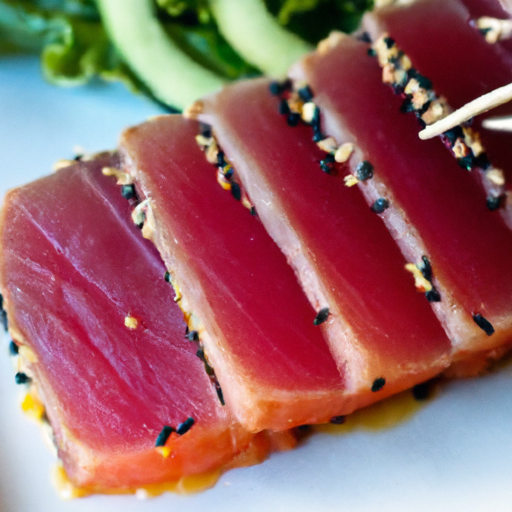Exploring the World of Ahi Tuna: A Delightful Seafood Sensation
If you’re a seafood enthusiast, there’s a good chance that you’ve come across the captivating ahi tuna. Known for its vibrant color and bold flavor, this fish has become a favorite choice for chefs and home cooks alike. Join us on a culinary journey as we dive into the fascinating world of ahi tuna, exploring its taste, cooking applications, nutritional value, and uncovering some intriguing history and facts.
Ahi Tuna: A Taste Sensation
Ahi tuna, also referred to as yellowfin tuna, is characterized by its lustrous pink to red flesh and a firm, meaty texture. Renowned for its mild yet rich flavor, it offers a delightful taste experience that can be compared to a blend of meat and fish, with a slightly sweet and buttery undertone. This makes ahi tuna a versatile ingredient that can be used in various culinary preparations.
From Sashimi to Seared: Culinary Uses of Ahi Tuna
One of the most popular ways to enjoy ahi tuna is in its raw form as sashimi. Served thinly sliced with soy sauce, wasabi, and pickled ginger, it offers an exquisite melt-in-your-mouth sensation. The distinct flavor and texture of ahi tuna make it a perfect match for raw preparations.
For those who prefer their fish cooked, ahi tuna truly shines when seared. The high-fat content of this fish lends itself beautifully to a quick sear, resulting in a caramelized crust while maintaining a rare to medium-rare center. It’s important not to overcook ahi tuna to preserve its tenderness and delicate flavor.
Apart from sashimi and searing, ahi tuna can also be used in a variety of dishes, such as sushi rolls, poke bowls, ceviche, salads, and even as the star of a delicious tuna steak. Its versatility allows for endless creativity in the kitchen.
Nutritional Bonanza and Health Benefits
In addition to being a culinary delight, ahi tuna offers numerous nutritional benefits. Packed with high-quality protein, it is a great option for those following a high-protein diet. A 3-ounce serving of ahi tuna provides around 25 grams of protein, making it an excellent choice for muscle growth and repair.
Ahi tuna is also a rich source of omega-3 fatty acids, known for their heart-healthy properties. These essential fats contribute to lowering the risk of heart disease and reducing inflammation in the body.
Additionally, ahi tuna contains vital nutrients like vitamin D, selenium, potassium, and B vitamins, which support overall health and well-being.
History and Fun Facts
Ahi tuna has been celebrated in culinary traditions throughout history. Native to warm tropical and subtropical waters, it has been harvested by various cultures for centuries. The name “ahi” comes from the Hawaiian word for fire, representing its fiery appearance and the intense heat needed to cook it to perfection.
In Hawaiian cuisine, ahi tuna holds a special place. It is a key ingredient in traditional dishes like poke, where it is cubed and marinated with various spices and sauces. Poke has gained immense popularity worldwide, showcasing the versatility and deliciousness of ahi tuna.
To ensure the sustainability of ahi tuna populations, responsible fishing practices have been implemented, including regulations on catch limits and the use of more selective fishing methods.
Explore the Culinary Delights of Ahi Tuna
Whether you’re a seafood aficionado or a curious home cook, ahi tuna offers an enticing culinary experience. Its delectable taste, versatility in cooking, impressive nutritional value, and rich history make it a seafood sensation worth exploring in the kitchen. So gather your ingredients, sharpen your knives, and embark on a delightful journey to savor the wonders of ahi tuna!
Ahi Tuna
Origin: Ahi tuna, also known as yellowfin tuna, is a species of fish native to warm waters of the tropical and subtropical oceans around the world. It can be found in the Pacific, Indian, and Atlantic Oceans.
Common Uses: Ahi tuna is highly valued for its culinary uses, particularly in raw or seared preparations. It is often used in dishes like sushi, sashimi, poke bowls, and tartares. Ahi tuna’s firm texture and rich, meaty flavor make it suitable for grilling, pan-searing, and broiling as well.
Nutritional Benefits: Ahi tuna is a healthy source of protein, vitamins, and minerals. It is particularly rich in omega-3 fatty acids, which are essential for heart health, reducing inflammation, and promoting brain function. A serving of ahi tuna can also provide B vitamins, selenium, potassium, and magnesium.
Unique Properties: Ahi tuna is known for its vibrant pink color, which turns beige when cooked. It has a firm and dense texture with a mild, slightly sweet flavor. Yellowfin tuna can grow quite large, with adults reaching up to six feet in length and weighing several hundred pounds.
Historical Significance: Ahi tuna has a long history of being an important food source for coastal communities. Traditional fishing methods, such as handline fishing, have been used for centuries to catch these fish. In Hawaiian culture, ahi holds cultural significance and is considered a symbol of strength and prosperity. It has also played a crucial role in the development of international seafood markets due to its popularity in Japanese cuisine.




Use the share button below if you liked it.
It makes me smile, when I see it.